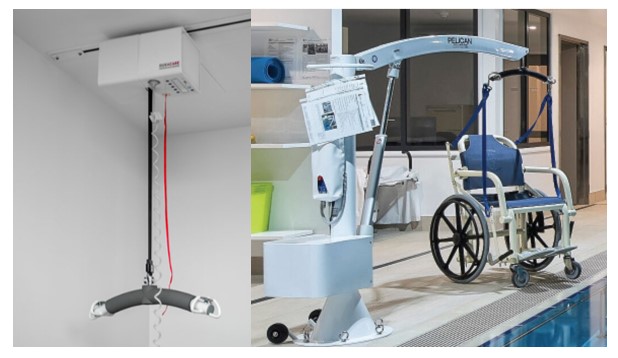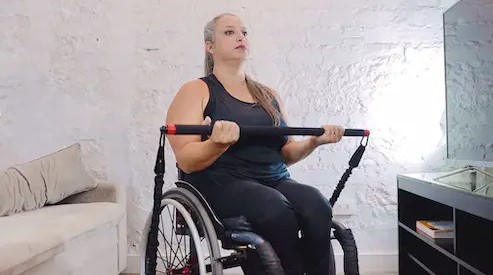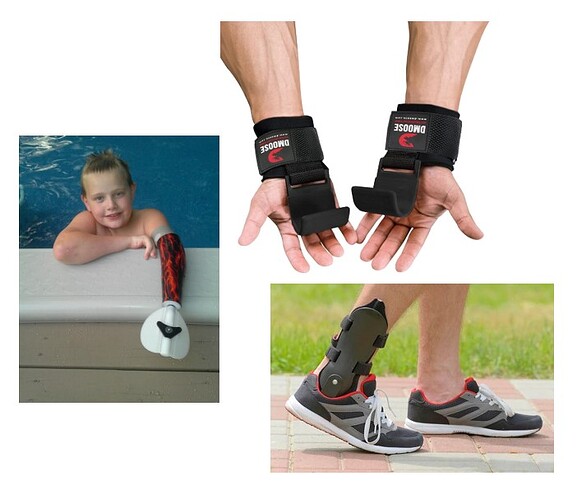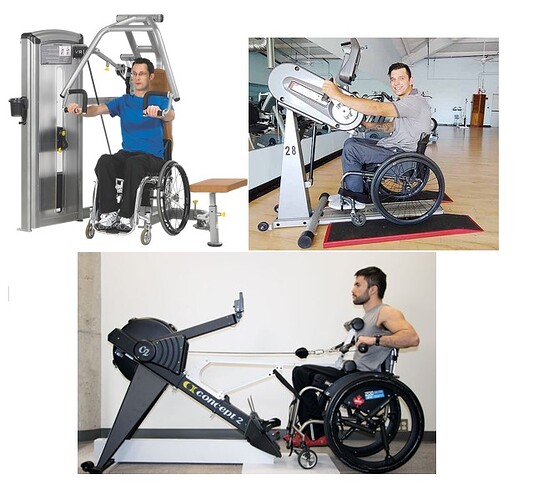So Jess is currently off compiling away looking at all the ART results from the October 3rd changes to now to get a better idea of what has been unsuccessful and what has been successful. We are planning a “plan of attack” article coming soon based on what she finds to help people better prepare. Until she is done you are all unfortunately going to be subject to my ramblings. Before we start if you are just after assistive technology for fitness you can scroll down to the sub heading.
Something that is very important to me is physical health and fitness. I have done weight training most of my life, I also studied older adult health and fitness back in my aged care days. There was a period in my life where I temporarily had to put everything on hold due to illness, medication complications and injury as well. I know how much that took from me and it was only temporary. It is a very big difference when you have something impeding you that is life long and chronic. It also really motivates me to want to help people who do have fitness goals but are impacted by their health and disability.
There is an issue in the industry where people see someone with a disability and fitness goals and under estimate what can be achieved. It can also happen outside of the industry with personal trainers and gym instructors. Being a weight lifter myself, over a decade ago, before I even entered the world of NDIS and when I was just dabbling in advocacy for people with chronic illnesses, I found myself inspired by the story of Johnathan Stoklosa. He is an American power lifter who was born with Down Syndrome. He competed in multiple Special Olympics, but was outlifting a lot of able bodied power lifters in his weight class on records. His adventure changed my whole perspective on what people with disabilities were truly capable of and how biases are sometimes holding them back. I am reminded of him now because he recently retired from power lifting after 20 years of being an absolute champion in the industry. We aren’t all going to end up being the next Johnathan, but everyone should have the opportunity to reach their own personal bests and goals. (link to a recent story about him in case anyone is interested Member Spotlight: Jon Stoklosa – Enhance® Magazine).
The goals don’t have to be big to have a massive impact either. One of my smallest goals has actually had one of the biggest benefits. All the goal was, was to regain length in my left calf muscle after a 16cm DVT clot demolished me. Little changes can make some really big differences. Everyone needs little goals and big goals. Focus on the goals that you are most excited about.
What holds people with disabilities back when trying to create and reach fitness goals?
There are several ways in which people get held back.
Often when a person with a disability has a fitness goal in mind they will go and try to research what is possible for them. They will do this by searching online where they are often met with a lack of representation. They may ask trusted family, friends or medical professionals and are more commonly met with opinions based on biases and in some cases an over protective “cotton wool” approach because of the disability.
I do tend to find that physiotherapists and occupational therapists are better at making suggestions that are beneficial and at getting past more of the biases, but some still take the conservative approach. They are also limited by funding. Exercise physiologists can be hit and miss in my experience but I have met some great ones.
Costs are another factor. In some cases all or part of what you need to achieve your goals can be funded through NDIS, and in others, nothing is funded and it is all out of pocket. If you are on a limited plan, limited income or are in a location with limited choices, it can really add up to you financially not being able to work towards your goals in a way that you would want to. The costs cause people to miss sessions, have fewer sessions than needed to meet goals and can also impact mental health as it becomes a stressor.
Lastly, finding the motivation to do the work outs can be a challenge. When you face a disability, finding the time to do your work out can be tricky, lining up supports can be challenging, pushing through emotional and physical burn out can be a steep climb. Sometimes just turning up and finding that equipment is not accessible to you can obliterate the motivation you had. One gym in Melbourne that no longer operates had 2 floors and set up all the weights upstairs, and cardio machines downstairs. There was a lift but it was regularly broken. For a wheelchair user who couldn’t use many of the cardio equipment it was a real bummer to get up, get dressed and get out there only to find that the lift was out. So many things can factor in to your long term motivation. I always say for both diet and exercise, the best plan is the one you will actually stick to. I also say if you weren’t feeling great and you could only give 20% effort, then you gave 100% of what you could give on the day. Don’t beat yourself up for doing a 100% effort on a 20% day.
What are the benefits of exercise goals?
Exercise builds your physical capacity, increases your independence and allows you to participate better in activities at home, school, work and in the community.
Some direct benefits of a program tailored specifically to you can include:
- Improved mental health, wellbeing and self-esteem
- Improved mobility and physical function
- Improved balance
- Increased fitness, endurance, strength, dexterity and flexibility
- Pain reduction
- Improved metabolic wellbeing
- Improved sleep
- Creation of a sustainable activity routine
- In group settings it can also improve your ability to socially interact with others including people with and without disabilities
So what are the options that are available to people with disabilities and what will NDIS cover?
Using public park gym equipment
This is a free option, sometimes not the most accessible. Also weather dependent. Not every park has a set up either. It can also be time dependent because there are some areas where it might not be safe for a person with disabilities to be out alone afterhours.
Going to the gym or pool on your own
We know gym memberships are not NDIS costs. The average gym membership costs $65 per month. There are cheaper options but whether you can access them depends on where you are located. This is a good option if your local gym is not cost prohibitive, you have an understanding of what exercises you need to do to reach your goals and you are able to travel. Some gyms allow you to bring a support person in for free if you need assistance while others have a charge. It is important to do your research. There are a small number of gyms that also have a reduced cost day or time period when they are quiet for people with disabilities to attend. There aren’t many gyms left that do that but it can make a big difference in cost over a year if you find one that does. If swimming is something you are interested some pools have MLAK accessible bathrooms with hoists and other mobility options like pool wheelchairs to help people with disabilities. Some need advanced notice that you will be coming and of what you will need.
Personal trainer
Personal trainers are not disability specific and not covered by NDIS funding. They can cost anywhere between $80-$200 per hour. They are very effective in one on one settings but also may lack knowledge of specific disabilities and illnesses. They can support you with activities in the gym. The option to attend group classes may reduce the overall costs but at the same time they may not be able to give you as much support in a group setting. You can attend classes with a support worker but some gyms require you to pay for the support worker to attend with you.
Exercise Physiologist
An exercise physiologist is a qualified allied health professional who can visit your home, work, school, or preferred local gym or facility to assist you with your exercise goals. They can be funded by NDIS if they see them as reasonable and necessary to help you achieve your goals. Some of them have equipment that they travel with. Others request that you purchase equipment or a gym membership in order to have equipment to use. They are charged under the health and well being code which is slightly less than the physiotherapy code. They also have knowledge of disabilities and support.
Allied health assistants
Allied health assistants vary in required qualifications state to state. They also must work under the guidance of a qualified allied health professional. If you do use one they can follow an exercise plan created by your physiotherapist and provide the same supports as the physiotherapist and report back. They can be funded by NDIS and because the hourly rate is lower you can get more hours each week than if you went with a physiotherapist to perform the same exercise. You will still require equipment to use either that you own or through a gym.
Physiotherapist
Many of you are familiar with Physiotherapy. You are also aware that it is funded through NDIS but can quickly chew through a plan if a lot of hours are needed. I do recommend that if you have a very complex set of issues that you ask for the funding to be fully supported with physiotherapy as much as possible. The expertise and knowledge can in some cases be necessary to help you progress. Some physiotherapy offices also have small gyms you can use and in some cases they can recommend some body weight exercises that do not require equipment.
Hydrotherapy
Sometimes called water treatment or aquatic physiotherapy, hydrotherapy involves exercising in a shallow pool of warm water. The water temperature is usually set at 32-34 degrees so that the only energy you are expending is through exercise and not maintaining your body heat. You can do it one-on-one with an experienced physiotherapist, exercise physiologist or allied health assistant or in a group class at a center. Centre costs are not covered by the NDIS but the support costs are. You also have the option to attend alone if you are a confident swimmer and do not need assistance entering and exiting the pool.
This is a good option if there is a risk of falls, if there is an injury, if there are mobility or impact issues with regular exercise and if recovering from surgery after any open wounds have fully closed. It can be hard to get motivated to go get wet in winter though. Some people may also be sensitive to chlorine.
Home gym/working out at home
This option can be a good option if you have the space and struggle with leaving the house. In the short term it can be cost prohibitive but long term it can save on gym fees. If anyone considers going down this route I always suggest purchasing in stages and I also recommend looking at buy swap sell groups. You can get some near new equipment for a quarter of the price from people who had grand ambitions. I have a home gym that I use for myself and my partner and it comes in handy when you know you really haven’t got much excuse to not go out. But this is not an option for everyone. The other option is using household furniture and body weight exercises and stretches to meet your goals. You need to make sure the furniture is suitable for your mobility, body weight and the exercises you are doing to prevent injury.
Support workers who are also qualified personal trainers or have exercise experience
Some people have gotten around the costs of having a personal trainer or allied health support by seeking support workers with a health and fitness background. If you are in generally good health without any serious complex issues that need more specialist attention, or if you have a plan from the physio to follow, this can be a really good option. They are NDIS funded, they can transport and support you, and they can use their knowledge to help you reach your goals.
Joining a disability specific sports team
If there is a particular sport you enjoy doing it might pay to search whether others with your disability or other disabilities have made a team in your local area. In some cases the fees for disability specific sports activities may be covered by NDIS although since October 3rd I have seen a couple of rejections so it is important to ask beforehand. Depending on your ability there may also be options to join mainstream teams but these are not going to be funded.
Following online health influencers for diet and work out advice
This one is free to use but is a controversial one for a few reasons. With the internet and social media being as accessible as it is to get information, it can be very tempting to go down this route. There are definitely some good, science based channels out there, and then there are others trying to push risky diets and exercise plans that even fit healthy people with no disabilities should avoid. There are also some just trying to make fast money selling scam products.
If your disability does not impact you in a way that may make unsupervised exercise risky and as long as you do your research on the option you choose to ensure that it is good information it can actually be a beneficial option. Both my partner and I follow a YouTube channel called Gravity Transformations as one example that I have found beneficial (link in case anyone wants to take a look https://www.youtube.com/@GravityTransformation/videos). It is more focused on weight loss and muscle building and has a wide variety of weight training videos. It also has videos discussing diet and other aspects of fitness. One of the things that I like most about it is that he links all of his information back to research papers and scientific studies. Another person I like to follow is a man on Facebook named Jeremiah who has a tongue in cheek approach to helping people with morbid obesity and “different” body types find exercises that work for them and their shape. He focuses mostly on body weight exercises for people with limited mobility. I follow him for the limited mobility aspects of his work outs as I have found many of them beneficial to people with different disabilities affecting different parts of the body. (link to one example of his reels as well 510 reactions · 23 shares | Try These Stretches For A Wide Load Body! #stretchingexercises #stretching #stretch | Jeremiah Daniel Johnson). There are quite a few options and as long as you do your research there are benefits to be had.
As you can see above there are several options and it is important to find the one that best suits you and meets your needs.
Assistive Technology
Once you have picked the option that suits you, that just leaves seeing whether there is assistive technology that could assist where needed. While there is a lot of equipment you are able to use as is, there will be equipment that may not fit your disability and it would be nice to find a work around. Lets look at some of the options.
So far I have only seen it once in my years of doing support work, but a quiet hour or sensory room in gyms for exercise can help people with sensory issues who struggle with the loud upbeat music often played in gyms. Noise cancelling head phones may be an option in these situations depending on the exercise you are doing.
The place where assistive technology is often featured most in health facilities is in the pool area. Accessibility in this area has improved for less mobile people significantly over the last few years. Most feature hoists, pool wheelchairs, ramps and slings.

Orthotics and prosthetics have also come a long way in being able to support people in achieving their goals and protecting themselves from injury.
Some standard disability equipment is now being adapted to turn into equipment that can be used to exercise. It never hurts to ask your physiotherapist if any of the equipment you already own and use can be adapted to help you work out.

And lastly, something that I have started slowly noticing in gyms and that I am hoping will take off, is gyms stocking equipment specifically for disabled users. Not every gym has these options yet so you would need to ask around. I know in some areas it was a matter of enough people asking for them to make the option available. These are also an option if you want to go the home gym path but you will find they run a little more expensive and are harder to find.
There are some other options out there that creative people have come up with but I will end it there. I hope that you learned something useful about getting into exercise goals. And as always, if you have any questions feel free to ask.

